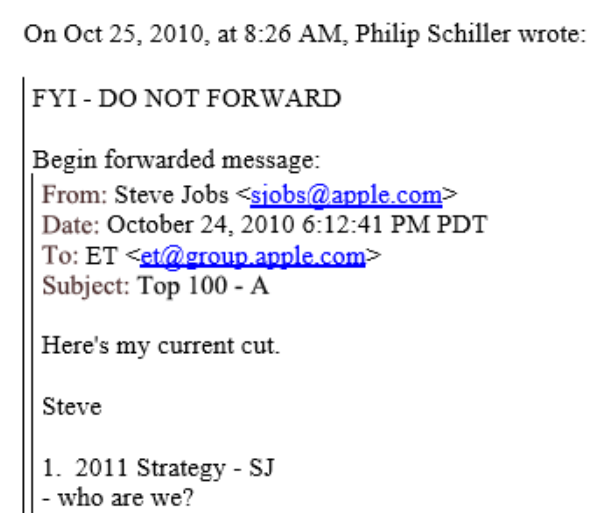Apple and the cloud: A magnificent missed opportunity

One of the saddest documents you’ll ever see is prosaically titled DEFENDANT’S EXHIBIT NO. 489.245. (I’ve shared it in a public folder at OneDrive, so you can click that link and read the whole thing at your leisure.)
The document, a printout from an internal email sent to a list of top Apple executives, emerged last month as part of the landmark patent infringement suit brought by Apple against Samsung.
The email was part of a thread that begins with a painfully ironic DO NOT FORWARD warning from Apple Senior Vice President Phil Schiller. It includes the forwarded text of a blunt agenda from Steve Jobs covering Apple’s plans for its 2011 fiscal year.

The dateline alone is poignant. Written in October 2010, the email represents Steve Jobs’ final opportunity to provide his guidance on Apple’s future. Jobs resigned 10 months after this email was sent and died of cancer two months after that.
But the even sadder part is how thoroughly Apple has so far failed to deliver on one of the key goals Jobs laid out in this, his final strategy document. Jobs wanted 2011 to be the “Year of the Cloud.” With the digital hub moving from the PC to the cloud, he said, Apple was “in danger of hanging on to [the] old paradigm too long.”
That summary by Steve Jobs is puzzling. On the one hand, as Apple’s Disruptor-in-Chief, he knew full well how important it is to disrupt your own business before you let someone else do it. He also recognized that both Google and Microsoft had a significant lead in cloud technology, even if they hadn’t figured out how to translate that technology into income or profits.
But on the other hand, Jobs also remained firmly wedded to Apple’s walled garden. His directive in this memo, which was never intended to be seen by us mere mortals, is extraordinarily blunt: “tie all of our products together, so we further lock customers into our ecosystem.”
So, three and a half years later, how far have Apple's cloud efforts progressed? Compared to the leaders in the cloud ecosystem, not very far at all.
Apple’s iCloud is, first and foremost, a backup target for iOS devices, a job it does reasonably well. But on every other modern yardstick for cloud computing it falls short. My colleague Jason Perlow (disclosure: he now works for Microsoft) has done an excellent job of summing up the cloud landscape in a pair of posts:
- 2013: Apple's Game of Services: Winter is coming
- 2014: Game of Services: Revenge of the cloud dragons
Both posts are must-reads. Here’s my current take on Apple’s cloud status:
- Email Apple has been bumbling along for a decade with @mac.com and @me.com and now @icloud.com addresses, but there’s no evidence they’ve gained any traction. Google and Microsoft have pretty much divided and conquered this space, with Yahoo and AOL hanging around among old-timers.
- Productivity apps Apple has some very capable iOS and OS X apps in its iWork suite: Pages, Numbers, and Keynote. All of them can be used to create, save, and edit files in iCloud. But there are no equivalent apps for non-Apple-branded devices, and the cloud-based versions of those three programs are still in beta. It is the embodiment of Jobs' "lock customers into our ecosystem" strategy. And it is a non-starter when competing with Google Apps and Office 365.
- File storage The explosion of general-purpose online storage options available today, including Dropbox, Google Drive, Microsoft OneDrive, and so many more, is remarkable. Most of them have synchronization clients for iOS and OS X. Apple has nothing in this space.
- Messaging iMessage and its companion app, OS X Messages, allow users of Apple-branded devices to chat with other people if they're using Apple-branded devices. FaceTime has the same Apple-only limitations, despite Jobs' promise when the service was launched in 2010 that it would be released as an open standard.
- Photos iCloud syncs photos and videos from iPhones to the cloud and then to other devices. It's possible to share those photos via the web, although the process is cumbersome. Windows PCs have limited support; Android devices are unsupported.
- Music/video/books On the music side, Apple’s iTunes ecosystem is more than a decade old and still dominant. Music downloads are dropping dramatically, which might explain, in part, why Apple is planning to purchase Beats Audio, with its streaming music service and its lucrative premium headphones business. iTunes does a respectable business in video sales and rentals using the surprisingly successful Apple TV set-top box (an actual Apple-branded TV exists only in Gene Munster’s dreams). Apple is under court-ordered restrictions in the books market, where Amazon dominates.
Featured
In short, Apple is in no danger of becoming a “devices and services” company anytime soon. What it offers is fine for anyone fully committed to Apple’s hardware. But as soon as you stray into Android or Windows devices, things get ... complicated.
Fortunately for Apple and its shareholders, the installed base of Apple hardware, especially iPads and iPhones, is too big for any cloud player to ignore. That position, as gatekeeper to the wealthiest segment of the PC and mobile hardware market, gives Apple an enviable position as power broker.
And in the current climate, that’s a potentially tremendous edge for Microsoft over Google. Office for iPad was an unqualified hit last month, and Microsoft has been aggressively developing its other products, including OneDrive, for iOS. Despite friction through the years, Apple and Microsoft have maintained a working partnership.
Meanwhile, Google, largely on the strength of its Android OS, remains public enemy #1 for Apple. The spate of lawsuits by Apple against Samsung and other Android handset makers are really part of a proxy war against Google. And indeed, if you look just a few lines earlier on the first page of this strategy document, you'll see the heading "2011: Holy War with Google."
Under those circumstances, especially with the Mac-PC wars mostly in the rearview mirror, it’s easy to see Apple developing tighter ties with Microsoft’s cloud.